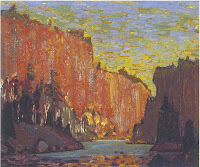Tom Thomson Was A Weatherman - Summary As of Now
Thomas John Thomson (born 5 August 1877 in Claremont, ON; died 8 July 1917, almost 40 years old ) circa 1905–10. |
I started doing presentations about the art and science of Tom Thomson in the mid-1980s. I did not keep count but the number of presentations certainly numbers in the hundreds. This mountain of material has grown into a book that is now being blogged a bit at a time.
Thoreau MacDonald (1901-1989), the son of JEH MacDonald of the Group of Seven, was also a friend of Tom and he wrote:
“Thomson’s work would be a fine study for some competent critic, but anyone attempting it should be familiar, not only with every phase of his work but with the country too, lakes, rivers, weather; have them in his bones … “
I prefer to be positive... being critical is not my style but my natural science background might bring fresh information to the Tom Thomson catalogue raisonné. This project will take some years to complete but I am in no rush.
In the draft of my "Tom Thomson Was A Weatherman" book, I included several chapters describing the meteorology and natural science employed to better understand his art. This information has already been written in the "The Art and Science of Phil the Forecaster" blogs which I have been compiling for many years. If you should encounter a term or concept that I do not adequately explain within the context of a particular Thomson work, a search of this site will certainly yield the answers. I will typically include linked references to the required background information with each painting.
The following is a list of the Blog entries to date accompanied by a representative image and a linked title to the Blog. Some paintings require more than one blog to fully explain. Tom accurately painted the truth of what he saw.
Arthur Lismer, his friend and Group of Seven member described Thomson as someone who "sought the wilderness, never seeking to tame it, but only to draw from it, its magic of tangle and season." That wilderness put the "wild" into his art.
Blodwen Davies included in the 1967 publication "Tom Thomson: The Story of a Man Who Looked for Beauty and for Truth In The Wilderness" that Tom Thomson had remarked: "Someday they will know what I mean." Hopefully, that day has arrived.
Note: Miss Blodwen Davies's passed in 1966 but she had previously sought help from Group of Seven artist A. Y. Jackson, who had written the Foreword to the first self-published version in 1935. That first printing was limited to 100 copies and the 1967 republished version of that scarce book is available to a larger audience.
Thank you for your interest. These posts have been a lifetime in coming.
Tom’s Tornado Two - Some Science
Tom’s Tornado Three - Some Art
Thunderhead: Pink Cloud over a Lake - Summer 1916
Lightning, Canoe Lake: Summer 1915
Tom Thomson’s Last Weather Observation
Updated May 2024
Tom Thomson's Burnt Land at Sunset - the dynamics of the weather was Tom's inspiration.
Spring Sunset, Algonquin Park Spring 1916 also holds some surprises... this story was never told.
The Marsh, Early Spring 1916 - a challenge to place the location but not in the weather.
Sunset Sky, Summer 1915 was indeed a sunset but was observed in the spring.
Sunset Sky, Spring 1915 was a spring painting but was actually a sunrise. This post has been years in the making and I have never included it in a “Tom Thomson was a Weatherman “ presentation. The last two posts lead to this one - a trio if not a quartet of skyscapes within a single event.
Stormy Sky Summer 1915. Actually a split cold front mid-morning in spring.
Fire-Swept Hills Summer or Fall 1915. Long-range Forecast: Continuing hot and dry for the rest of the 21st "Century of Fire".
Ragged Lake Alternate titles: Northern Lake; Ragged Creek Fall 1915
Autumn Clouds Fall 1915 Dynamic cloud shaped by the wind bathed in the light of sunset tell an intriguing story of science and the weather.
Evening Cloud Alternate titles: Evening Clouds; Storm Cloud; Storm Clouds Fall 1915 Hers is the real story... cumulus congestus at a cold frontal passage wearing the Belt of Venus...
Tea Lake Dam Fall 1915 certainly painted in the spring with logs going to market - probably 1916.
Moonlight Fall 1915 Actually painted in the spring of 1916... on the evening of April 18th about 18 hours before Ragged Pine, Spring 1916.
Abandoned Logs Fall 1915 Those logs were not abandoned in the spring of 1916 when Tom observed the log drive along Carcajou Creek. The tall pile of logs was a landing piled high by the hard-working lumbermen.
Sketch for "The Drive" Fall 1916 After painting Abandoned Logs Tom probably strolled 100 metres along the western bank of Carcajou Creek to were the lumbermen were actively guiding logs through the sluiceway of the dam on the May morning in 1916.
Bateaux Summer 1916 Actually Pointers and there is quite a story to be told.
Aura Lee Lake Spring 1916. Aura Lee Lake which is now known as Laurel Lake was definitely not an arduous canoe trip downstream from Little Cauchon Lake where Tom and his friends were fishing and painting up a storm!
The Lake, Bright Day, Fall 1916 The clouds tell the story.
Spring Break-up, 1916 The underlying story is of a clear-cut forest with nothing to hold back the spring floods. The cracks in the shoreline ice hold those clues.
Portage, Ragged Lake Spring 1915 This is a story of icy swirls. Tea-stained ice pans swirling in the turbulent waters of the outflow from Ragged Lake during the spring flood.
Red Pines, Little Cauchon Lake, Algonquin Park, Spring 1916 The story can be discovered by strolling behind the Red Pines to take a closer look at the sky.
The Sketch for the Jack Pine 1916. Imagine a solitary tree exposed on the rocky shore of a northern lake facing the elements alone. Simply staying alive was a victory. Thomson captured that iconic message in oils. "The Jack Pine" has become the metaphoric touchstone of the Canadian experience. Like the seeds of a torched Jack Pine, Thomson's art could only be sown after his death to inspire the next generation of artists.
Little Cauchon Lake, Spring 1916 A story from the fishing trip of late April 1916. TT-134
Pine Cleft Rocks Spring 1916
Little Cauchon Lake, Spring 1916
Landscape, Sunset Spring 1916
Tamarack Swamp Fall 1916
Boathouse, Summer 1916
The Dead Pine, Fall 1916
Autumn, Petawawa, Fall 1916 (1916.94)
Spring Lake, Fall 1916 (1916.117)
Pine Tree, Summer 1916 (1916.84)
Phantom Tent, Fall 1915
Tamaracks Alternate titles: Purple Distance; Yellow Trees Fall 1915
Tamarack Swamp Alternate title: Tamarack Fall 1915
Round Lake, Mud Bay Alternate title: Geese, Round Lake, Mud Bay Fall 1915
November Day Alternate title: A November Day Fall 1915
Sunset, Canoe Lake Alternate title: Canoe Lake Fall 1915
Northern Lake Alternate title: Northern Lake, Spring Summer 1916
Poplars by a Lake Alternate title: Lake Through Trees Summer or fall 1916
Petawawa Gorges Alternate titles: Cliff Landscape; Storm Over River Fall 1916
View from a Height, Algonquin Park Fall 1916
Ragged Pine Fall 1916
Birch by a Lake, with Big Cloud Alternate titles: Birch by a Lake; Birches; Clouds over a Lake Fall 1916
Autumn, Algonquin Park 1916
Lake in Autumn Alternate titles: Late Afternoon?; Swamp in Fall? Fall 1916
Canoe Lake, Algonquin Park Fall 1916
Pink Clouds Fall 1916
Wild Geese: Sketch for "Chill November" Alternate titles: First Snow Ducks; Sketch for "Chill November" Fall 1916
Sunset, Canoe Lake Fall 1916
Hills in Autumn
The ability of nature to inspire and heal can be magical. The preceding articles were never intended to teach the incredible complexities of physics or meteorology. The goal was simply to encourage the reader to look at the natural world from a fresh perspective - to appreciate the magic of nature and perhaps become a "weather walker" and a protector of the environment.
Tom was inspired by the super-natural that he witnessed through his brief forty years. That world is being threatened by unsustainable consumption which is the source of all environmental issues. The reader inspired by Tom's art and nature might be moved to take action for future generations as we careen through the Sixth Mass Extinction and Earth's Loss of Biodiversity. That was the other goal of this effort disguised as art history. Art and science can be compatible.
Of course, you may simply wish to enjoy the art of Tom Thomson and that is absolutely fine as well - even encouraged! As Claude Monet said: “Everyone discusses my art and pretends to understand, as if it were necessary to understand, when it is simply necessary to love.”
I always left the last word for Tom Thomson at the end of every "Tom Thomson Was A Weatherman" presentation. On Saturday, July 7th, 1917 the day before he died, Tom wrote to his patron Dr. James MacCallum: "Will send my winter sketches down in a day or two and have every intention of making some more..." Tom was not finished his artistic journey!
 |
| Tom Thomson May 1917 at the campsite firepit. The last picture of Tom that I am aware of... |
There are many more articles to come but it takes time to translate the "Tom Thomson Was A Weatherman" book into blogs .. and I still need to follow my own artistic journey - and catalogue raisonné as well. I prefer to tell my own story so that any mistakes are my own.
Warmest regards and keep your paddle in the water,
Phil the Forecaster Chadwick
PS: I once corresponded with Ross King, the author of "Defiant Spirits" and he considered that the "ancient question of St. Hilary of Poitiers—“Who can look on nature and not see God? ”—can be given a Canadian twist. Who can look on nature and not see Tom Thomson?" That phrase does indeed sum up the art and science of Tom Thomson.


















































































